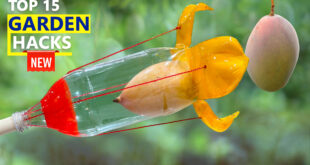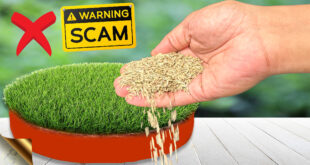In Today’s post, we will list some of the best natural pesticides that are approved by the USDA for organic farming and organic gardening. We will also learn how to use these correctly to get rid of all types of pests in your garden.
The pesticides approved in organic farming are largely the natural ones, though a limited amount of synthetic substances are permitted.
Let’s list these synthetic and natural pesticides used in organic farming and learn how to use them one by one.
1. BORIC ACID AND BORAX: This powder is commonly used to play carom has many uses in gardening. It’s mainly used to treat soil pests and insects like millipedes and also for ant control. Just sprinkle the boric acid over the areas of infestation and do not water for at least 24 hours. It acts as a contact poison and also as a stomach poison when the pests ingest this powder.
2. COPPER SULPHATE: This is used both as a fertilizer as well as a fungicide. As an anti-fungal, it can be used in the prevention and treatment of fungal diseases like the Powdery mildew, Leaf rust, black spot rose disease and any other serious fungal disease. This is the most effective anti-fungal in organic gardening.
How to Use it? Mix 20 grams of copper sulfate into 1 litre of water in a spray bottle and spray it on the affected plant. You can repeat this process after 1 week. Prepare only the required solution for the day and do not store it for next use.
3. TRICHODERMA VIRIDE: This is a certified bio-fungicide and is normally present in soil which controls other pathogenic fungi and prevents root rot and other harmful soil fungi. So, this can be used in the treatment of soil fungi, root rot, damping off in seedlings and also to treat fungus affected seeds or to prevent fungal infestation of seeds.
How to use it? For Preventing Canker and stem rot after pruning, make a solution by adding 10 gms in 100 ml water and apply this on the injured stem after pruning to prevent fungal disease.
To Prevent Seed Fungus, add 10 gms powder to 1 kilogram of seeds and mix well.
For plants that are wilting and you suspect a fungal disease in soil and root rot, mix 10 gms per litre of water and drench the plant and soil. Repeat after a week if necessary.
To Mix it in your potting mix, add about 10 gms to a potting mix volume of a 12 inch container and then repot your plant. This is particularly beneficial when you transplant your seedlings into fresh potting mix.
4. BAKING SODA: This is pure sodium bicarbonate which is mainly for cooking purpose and readily available in your kitchen. To use it as a fungicide, you can mix 2 to 3 teaspoons of baking soda in 1 litre of water and mix well and spray on the affected parts. If you want to make it more effective and a universal pesticide, you can add 1 teaspoon of oil like neem oil to this solution plus some 10 drops of liquid soap and spray on the plant. You can also use any vegetable oil, but best is neem oil and also clove oil or eucalyptus oil. Repeat this spray every week till your problem is solved. Apart from this there are about 10 uses of baking soda in gardening. You can check a detailed post on baking soda in garden.
5. DIATOMACEOUS EARTH: This magical organic powder has many uses in gardening like ant control, slug and snail control, preventing animals and rodents in your garden and mainly as an organic pesticide effective against all types of pests like aphids, mites, thrips, mealy bugs, caterpillars and even soil pests and insects. The mechanism of action is it’s a contact poison which kills pests by extreme dehydration. You can check a detailed post on DE powder.
How to use Diatomaceous earth on plants?
First of all Water your plants for the day. Then dust the plants with an applicator or just sprinkle the powder on your plants. To avoid killing beneficial pollinators like bees and butterflies, do not sprinkle on flowers.
6. HYDROGEN PEROXIDE: Though it a chemical with formula H2O2, which is similar to that of water, but with an extra oxygen atom. This concept is the key for using hydrogen peroxide in gardening. Well, to use it as an effective pesticide and antifungal, add 1 cup that’s about 250 ml of 6% hydrogen peroxide per litre of water or 2 cups of 3% h2o2 per litre of water. Load it in a spray bottle and spray on the plants. To control Fungus gnats and soil pests, you can water the plant with the same solution. Apart from this, hydrogen peroxide has many other miraculous uses like to save a dying plant, as a fertilizer and many other beneficial uses. You can check a detailed post on hydrogen peroxide in gardening.
7. VINEGAR: this is chemically called Acetic Acid. It’s an inexpensive product and found in most kitchens. In gardening we use 5% white vinegar or the distilled white vinegar. For the treatment of powdery mildew or spot fungus, add One cup of White Vinegar to 1 litre of water and shake well and spray it on the affected leaves. To use it as a pesticide, Add one cup white vinegar to 1 litre of water and then add some 10 drops of liquid soap and spray on the affected plants. You can check a detailed post on uses of vinegar in garden.
8. NEEM OIL: Neem oil is by far the best Organic Pesticide available worldwide. Azadirachtin and Nimbin found in neem oil are the two major compounds responsible for its antibacterial and antifungal actions. It is in fact a broad spectrum pesticide and the safest and most effective of all organic or natural pesticides. To learn about how to use it, the dosage and the patch test, You can check a detailed post on neem oil for plants.
 GKVKs – Gardening Tips and Store Gardening Tips and Store
GKVKs – Gardening Tips and Store Gardening Tips and Store



